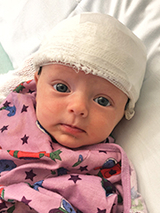Lucy’s Story: Going All In to Cure a Rare Disease
Lucy’s Story: Going All In to Cure a Rare Disease
Erin and Ben were overjoyed to welcome their second child Lucy to their family. But when they look back on her third day of life, the first word that comes to mind is “traumatic.” Lucy and her mother were both doing well after she was born at Pennsylvania Hospital, but the day before the family expected to be discharged from the hospital, Lucy had a seizure.

“The rug was ripped out from under us,” says Erin.
Lucy was transferred to the neonatal intensive care unit (NICU) and placed under the care of Christina Bergqvist, MD, a Senior Pediatric Epileptologist at Children’s Hospital of Philadelphia (CHOP) who specializes in the care of infants and children with epilepsy.
Lucy stayed in the hospital for a week and underwent a battery of tests, including a CT scan, an MRI and an electroencephalogram (EEG). However, none of the tests were able to identify a cause for her seizures. She was given a medication that stopped the seizures and was discharged home. The family was hopeful that the seizures would not return.
However, after two months, Lucy’s seizures returned, became difficult to treat and quickly evolved into infantile spasms. Infantile spasms are a severe seizure type that for Lucy involved repetitive jerks of her muscles that lasted between three and five minutes.
“To watch her continuously seize for minutes at a time, several times a day, it was awful,” says Erin. “A minute doesn’t seem like that long but when your child is having a seizure it’s eternity.”
Lucy was admitted to CHOP. Because Lucy did not have an infection or an injury to her brain that was causing her seizures, Dr. Bergqvist was suspicious that a genetic cause may be playing a role. A genetic test called an epilepsy panel was completed and pinpointed the cause of Lucy’s seizures as a mutation in a gene called STXBP1, which causes a rare neurological condition called STXBP1 encephalopathy. At the time there were only about 300 people in the world diagnosed with this genetic condition, which can cause recurrent seizures and developmental delays. The news hit Lucy’s parents hard.
About STXBP1 encephalopathy
Mutations in the STXBP1 gene cause a spectrum of neurodevelopmental disorders that can include early-onset epilepsy and developmental delay.
The family was referred to pediatric neurologist Ingo Helbig, MD, in CHOP’s Epilepsy Neurogenetics Initiative (ENGIN) Clinic, which provides access to expert care for children with genetic epilepsy syndromes.
Dr. Helbig is an internationally recognized expert in genetic causes of childhood epilepsies and has particular expertise in STXBP1 encephalopathy. Within ENGIN, he cares for many children with STXBP1 encephalopathy and is a leader in research into this rare genetic disorder. Dr. Helbig and his team met with Lucy and her parents and helped them define a path to move forward.
Going all in on a search for a cure

After the appointment with Dr. Helbig, Erin and Ben decided to put their combined skills to work and take action. The genetic testing gave a name to Lucy’s condition and identified a target for research and potential treatment. The family joined forces with Dr. Helbig and his team in ENGIN to tackle this rare disease.
Ben — known professionally as Benjamin Prosser, PhD — is a cardiac researcher and assistant professor at the University of Pennsylvania. He read everything he could find about Lucy’s condition. He dedicated part of his cardiac lab at Penn to neuroscience and began working with Dr. Helbig and the ENGIN team and Beverly Davidson, PhD, and her team to study novel and innovative therapies to treat STXBP1 encephalopathy at the gene level. Dr. Davidson is Director of the Raymond G. Perelman Center for Cellular and Molecular Therapeutics and Chief Scientific Strategy Officer at CHOP. She is a world leader in gene therapy in neurological disorders. Jointly with Dr. Helbig, Dr. Davidson also serves on the Scientific Advisory Board of the STXBP1 Foundation.
Erin had spent 14 years in marketing and communications before dedicating herself full-time to Lucy’s care. To help fund STXBP1-related research, Erin and Ben spearheaded “Lulu’s Crew,” a team for the Million Dollar Bike Ride, a fundraiser for rare diseases organized by Penn’s Orphan Disease Center.
“We like to think Lucy picked us,” says Erin. “Like, ‘Between a marketing mom and a scientific dad, they’re going to get me through this.’”
Erin and Ben reached out to friends, family and former colleagues from Baltimore to Boston. They amassed a team of 70 riders and raised nearly $140,000; it was both the largest team and the most money raised by a team in the event’s history. More than 1,000 individual donors rallied to support the Prosser family.
“The Million Dollar Bike Ride was cooler than our wedding,” says Erin. “When your child is diagnosed with something like this, you feel alone and like no one understands. Just to feel that overload of love and support, it was a really emotional day.”
Finding success with keto while working toward a cure

While the family has been fighting to move research forward, Lucy continued to have seizures. Because standard medications were unable to stop Lucy’s seizures, Dr. Bergqvist recommended the ketogenic diet, a high fat, low carbohydrate medically prescribed diet that can be effective at stopping seizures in children with difficult to control epilepsy. Dr. Bergqvist is also the Director of CHOP’s Dietary Treatment Program, the largest in the world, which includes dieticians, nurses, social workers, and a dedicated medical chef, who have all supported Lucy’s family as they have adjusted to a new lifestyle to help bring Lucy’s seizures under control.
“Dr. B has been a godsend. She has been so on top of Lucy’s seizures — pushing for EEGs, visiting us in the hospital, helping us fight with insurance companies, and encouraging us to try keto,” says Erin. “We’re so lucky to have her as Lucy’s neurologist and a major part of her care team.”
Dr. Bergqvist and her keto team have been instrumental in educating the family on the diet and helping them adhere to it despite its challenges. Thanks to the ketogenic diet, Lucy has now been seizure-free for more than a year!
“I wasn’t convinced it would work,” says Erin of the ketogenic diet. “I thought, ‘How would changing what we feed her work if these strong anti-epileptic drugs and steroids aren’t working?’ But honestly, it’s the only thing that has worked.”
Lucy is now a sweet and snuggly little girl on the verge of her second birthday. She loves balloons, peekaboo, and “This Little Piggy,” but most of all she loves playing with her 4-year-old brother, Sam. She receives occupational therapy, physical therapy, special instruction, and speech therapy every week through early intervention services. Thanks to her and her parents’ hard work, she can now sit and give high fives. She is currently working on learning to crawl and clap her hands, and will hopefully one-day stand and walk.
If it wasn’t for genetic testing we may have gone years without a diagnosis for Lucy,” Erin says.
As painful as it was to find out about Lucy’s diagnosis, it was helpful to know about it early on so that we could get her into early intervention and therapy as quickly as possible to try and combat some of the global delays associated with this disease.
The family is hopeful that their research and fundraising efforts will advance innovative treatments that will give kids with STXBP1 a better life.